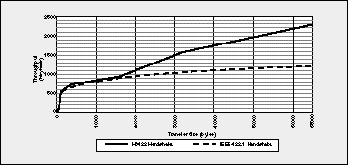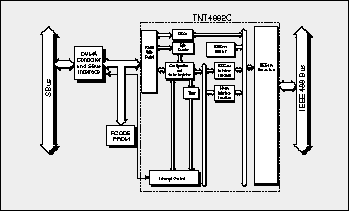
GPIB Interface Kit for Sun SPARCstations
GPIB-SPRC-B
 Features
Features
* Complete IEEE 488.2 Controller capability and maximum performance using the TNT4882C ASIC
- Completely IEEE 488.2 compatible
- FIFO buffers to decouple GPIB transfers from SBus transfers
- Byte-to-long word (32 bit) packing and unpacking in hardware to increase throughput and efficiency of SBus
- GPIB monitor port for board and bus-level diagnostics
- Complete in-system functional testing with loop-back mode
- Reduced software overhead
- Software and register compatible with Turbo488/NAT4882 chipset
* Maximum GPIB transfer rates
- 1.4 Mbytes/s using IEEE 488.1 handshake
- 3.6 Mbytes/s using HS488
* SBus DVMA data transfers
* No jumpers - software-controlled configuration
* Loadable NI-488.2M driver for simple installation
* Signal handling for immediate servicing of GPIB events
* Software compatible with all previous versions of SB-GPIB
* Application software - LabVIEW and LabWindows/CVI
Kit Contents
SB-GPIB/TNT board and NI-488.2M software for Solaris
|
Computer/Bus | Sun SPARCstation SBus |
| Processor | SPARC |
| Operating System | Solaris 1, Solaris 2 |
Overview
The GPIB-SPRC-B is a low-cost, high-performance IEEE 488 interface kit for
Sun SPARCstation Series workstations equipped with SBus slots. The kit includes
the SB-GPIB/TNT interface board and NI-488.2M software for Solaris. The National
Instruments TNT4882C ASIC makes the SB-GPIB/TNT a maximum-performance IEEE 488.2
interface board. The TNT4882C chip performs the basic IEEE 488 Talker, Listener,
and Controller functions required by the most recent GPIB standard, IEEE 488.2.
With the TNT4882C and the SBus Direct Virtual Memory Access (DVMA) transfers,
data transfers can reach 1.4 Mbytes/s using
the IEEE 488.1 3-wire handshake. The TNT4882C can significantly increase the
throughput of the associated multitasking Solaris driver software. The
SB-GPIB/TNT also implements a high-speed GPIB protocol (HS488), so that you can
have data transfers up to 3.6 Mbytes/s.
You can install the SB-GPIB/TNT in any single-width master SBus slot. Standard
IEEE 488 cables connect the SB-GPIB/TNT to up to 14 instruments. If more than
14 instruments are required, you can add instruments to the system with
National Instruments IEEE 488 extenders and expanders. You can install several
SB-GPIB/TNT boards in a single computer. The special GPIB monitor and diagnostic
circuitry can monitor the status of any GPIB lines, for applications such as
testing the proper low-level functionality of an instrument's IEEE 488 port.
HS488
The SB-GPIB/TNT uses a new high-speed GPIB protocol (HS488). HS488 increases the
maximum data transfer rate of ANSI/IEEE Standard 488.1-1987 up to 8 Mbytes/s.
HS488 is a superset of the IEEE 488.1 protocol that will attempt to conduct
transfers using the new high-speed protocol. If all active Listeners are not
HS488 capable, it will automatically use the IEEE 488.1 3-wire handshake
protocol. Maximum data transfer rates obtainable using HS488 depend on the host
computer architecture and system configuration. With the SB-GPIB/TNT, you can
attain transfer rates up to 3.6 Mbytes/s.
The TNT4882C completely and transparently handles the HS488 protocol without
additional circuitry. Because HS488 is a superset of IEEE 488.1, you can mix
existing GPIB devices with devices that have high-speed capability without
changing your application programs. The TNT4882C can implement high-speed data
transfers automatically. Thus, devices that have the TNT4882C chip can transparently
com-municate using HS488 if the corresponding Talker or Listener can also use
HS488.
The TNT4882C provides the ability to enable or disable the HS488 handshake
from software, and GPIB transceivers that meet the preferred specifications from
IEEE Standard 488.1-1987.
 Transfer Rates
Transfer Rates
The SB-GPIB/TNT hardware and software provide maximum performance. Figure 1
illustrates the data transfer performance of the SB-GPIB/TNT in a SPARCstation 2
for transfers below 64 kbytes in size. Actual obtainable data transfer rates
depend on host computer, system configuration, and device capability.
 Hardware
Hardware
Figure 2, the SB-GPIB/TNT block diagram, illustrates the key functional
components of the hardware. The following paragraphs describe these components.
TNT4882C - The TNT4882C ASIC,
the first single-chip IEEE 488.2 Talker, Listener, and Controller interface,
combines the circuitry of the NAT4882 IEEE 488.2 Controller ASIC and Turbo488
performance-enhancing ASIC from National Instruments, along with built-in IEEE
488.1-compatible transceivers. The TNT4882C also implements the HS488 mode of
operation for high-speed GPIB data transfers.
The TNT4882C implements Automatic Handshake Holdoff on the last byte of a GPIB
read, DMA Transfer Synchronization with IEEE 488 handshake, and Automatic END
transmission on the last byte of a GPIB write. Because the SB-GPIB/TNT performs
these functions in hardware, you save significant CPU time relative to
performing the same functions in software.
DVMA Controller And SBus Interface - The DVMA controller and SBus
interface functions are handled by the LSI 64853A ASIC. The DVMA controller packs
and unpacks each byte of the GPIB to the 32-bit-wide data path on the SBus.
Interrupts from the TNT4882C are routed through the SBus interface circuitry to
the SBus interrupt request line INT2*. SBus boards use SBus geographical
addressing, so there are no user-configurable jumpers on the board.
Because of the byte-to-longword packing and unpacking circuitry in the DVMA
Controller, the SPARCstation can communicate across the SBus in full
32-bit mode rather than in single bytes.
The SBus DVMA controller also has a internal data buffer to handle four-word
burst transfers. Additional registers that pipeline data transfers are also
present, reducing the overhead between data transfers. This is possible because
the address and the count of the next transfer can be loaded while the previous transfer is in progress.
FIFO - An 8-bit by 16-deep FIFO buffer on the SB-GPIB/TNT buffers data
sent to or received from the GPIB. By buffering the data, the SBus and the GPIB
can overlap their respective accesses to the FIFO, rather than one bus waiting
for the other to complete a cycle. This increases the data transfer rate.
Data Transceivers - The data transceivers embedded in the TNT4882C also
meet the current driver requirements of the SBus specification.
Transfer State Machine - The transfer state machine implements Automatic
Handshake Holdoff on the last byte of a GPIB read, DMA Transfer Complete
Synchronization with IEEE 488 handshake, and Automatic END transmission on the
last byte of a GPIB write. Because the SB-GPIB/TNT performs these functions in hardware, you
save significant CPU time relative to performing the same functions in software.
GPIB Monitor - You can monitor and control the IEEE 488 bus through a
16-bit read/write port independent of the IEEE 488 interface functions. The port
outputs are disabled at system reset and do not interfere with normal IEEE 488 operations. The ability to read and write
all 16 IEEE 488 lines gives a mechanism for stand-alone functional testing of the SB-GPIB/TNT or other instruments. The
monitors are part of the TNT4882C circuitry.
GPIB Transceivers - Transceivers, which provide power-up/power-down bus
protection (glitch-free) interface the SB-GPIB/TNT to the IEEE 488 bus.
The transceivers are part of the TNT4882C circuitry.
Driver Software
The following NI-488.2M software is included with the SB-GPIB/TNT:
* NI-488.2M for Solaris 1
* NI-488.2M for Solaris 2
Application Software
You can use the following application software with the SB-GPIB/TNT:
* LabVIEW
* LabWindows/CVI
Part Numbers
Hardware and Software Kit
GPIB-SPRC-B 776789-01
GPIB Cables
Type X2 double-shielded GPIB cable
1 m 763061-01
2 m 763061-02
4 m 763061-03
8 m 763061-04

Copyright 1996 National Instruments Corporation. All rights reserved. Product and company names listed are trademarks or tradenames of their respective companies.

